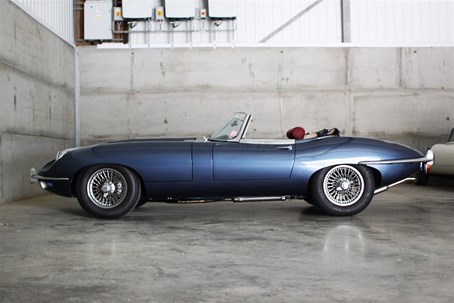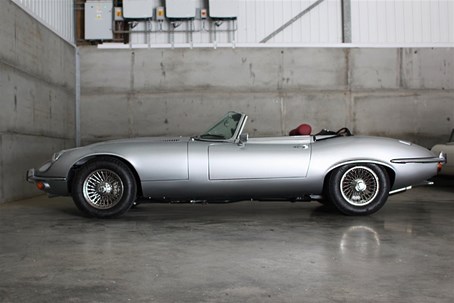History of E-Type
The iconic Jaguar E-Type has a long history, with three series of the car produced over a period of 15 years. The British sports car was reputedly named the “most beautiful car in the world” by none other than Enzo Ferrari and is often considered to be one of, if not the greatest, sports car of all time.
The First E-Type Jaguar
The first ever E-Type Jaguar was the product of dedicated development at the hands of the Jaguar racing team following the D-Types iconic success at the Le Mans 24 hour race in the previous decade.
The car was first displayed to the press on 15 March 1961 to an unbelievable level of excitement, giving birth to a true automotive icon - but it almost wasn’t to be. Such was the demand for road tests from the British media that the E-Type scheduled for Geneva was still on UK shores on the evening of 14 March 1961.
So, in fittingly dramatic style, Jaguar executive Bob Berry drove the car flat-out from the factory in Coventry all the way to the Parc des Eaux-Vives in Geneva - arriving just 20 minutes before the car was to be revealed to the world. Of course, 20 minutes later, pandemonium ensued.
The car was revolutionary in many ways, but it was the stylish and iconic bodywork that set it apart from the rest of the cars currently in production. It also featured faired-in headlights and a centred twin exhaust, which was different to all other production models at the time. Rumour has it that Enzo Ferrari called it “the most beautiful car ever made” when it was released.
It wasn’t just the looks that impressed many about the Jaguar E-Type and made it one of the most desirable cars in production, though. The launch price of the car was around £2,250, comparatively valued at £38,000 in today’s money, which made it surprisingly more affordable than many other sports cars. Although the same can’t be said for the cost of the Jaguar E-Type today, as its iconic history has made it an expensive vintage on the modern market.
It also featured much more modern specifications such as independent rear suspension and all-around disk brakes that put it ahead of its time.
The E-Type Jaguar Engine
The 3.8-litre engine produced 265bhp and could reach a top speed of 150mph, which made it the fastest production car in the world at that time. That was just as well, as Jaguar had already printed brochures claiming it was capable of the magic 150mph before the car went into production.
Jaguar E-Type Models
The era of the E-Type is characterised by three distinct phases of three different models of E-Types from its beginning in 1961 to the final production run in 1974: Series 1, Series 2 and Series 3.
The Series 1 was such a collection of developments that it’s sometimes ambiguous which cars fall into which category. The E-Type's later model revisions were formerly known as "Series 2" and "Series 3," and over time, the earlier models have come to be known as "Series 1."
Series 1
The FHC or Fixed Head Coupé, a two-seater coupé version of the E-Type, and a two-seater convertible "roadster" (OTS or Open Two Seater) were both debuted as rear-wheel drive grand tourers. In 1966, a "2+2" four-seater coupé with a longer wheelbase was introduced.
Within the Series 1 category, you’ll find two different engine sizes, which is how the Series 1 E-Types are differentiated. Between 1961 and 1964, the E-Type was fitted with a 3.8L engine and the majority had partial synchromesh transitions, but between 1965 and 1967, the upgrade was a 4.2L engine, increasing torque, horsepower, and many modern additions for that point in history.
Series 2
Due in major part to directives from the US National Highway Traffic and Safety Administration, the Series 2 E-Type incorporated a number of design developments. The absence of glass headlamp covers is the most recognisable outward element; unlike other cars, the E-Type adopted this practice globally. The wrap-around rear bumper, larger front turn signals, tail lights below the bumpers, an expanded grille, and twin electric fans to help with cooling are further distinguishing features of Series 2 E-Type Jaguars.
Series 3
In 1971, the final model of the historic E-Type was first manufactured. The Series 3 E-Type was only produced as a convertible and 2+2 coupé, after the short wheelbase was discontinued.
With a new 5.3L Jaguar V12 engine - and the badge on the back to prove it - as well as improved brakes and power steering, the Series 3 E-Type managed 272 hp, more torque, and a 0–60 mph acceleration in less than seven seconds.
The large cross-slatted front grille, flared wheel arches, wider tyres, and four exhaust tips are the classic identifying features of the historic Series 3.
Jaguar on the American Market
The Jaguar E-Type was known as the Jaguar XK-E for the North American market. In fact, such was the popularity of Jaguar on the US market, that some of the changes made to comply with rules and regulations in America were implemented across the manufacturing process for some series.
How many E-Type Jaguars are left?
There were 38,419 Series 1 Jaguar E-Types manufactured, 18,809 Series 2 Jaguar E-Types and 15,287 Series 3 Jaguar E-Types. Additionally, there was a single 1962 E-Type Lightweight Low Drag Coupé, and 12 Lightweight E-Types with two spare bodies.
Overall, this means that 72,528 Jaguar E-Types have been produced. Of course, it’s impossible to say for certain how many remain as a result of the worldwide spread and varying states of operation and disrepair of many E-Types and those with less known owners are often more anonymous. In the UK today, 4,565 E-Types remain licensed for road use.
E-Type has been - and continues to be - one of the most desirable cars ever made, with celebrity owners including some of the biggest names around. Frank Sinatra is said to have taken one look at the Jaguar upon its 1961 reveal and said “I want that car, and I want it now” - just the beginning of the E-Types love affair with celebrities. Other famous owners included George Harrison, Roy Orbison, George Best, Tony Curtis and Peter Sellers to name a few.
Look back at Car and Driver’s 1961 review of the Jaguar E-Type here, or contact us if you're looking for jaguar restorers in the uk.
| Series 1 | Series 2 | Series 3 |
| The Series 1 E-type ran from March 1961 to December 1968 with a total of 33,205 cars produced. | The Series 2 E-type ran from October 1968 to September 1970. There was a total of 18,808 cars produced. | The Series 3 E-type ran from March 1971 to February 1975. In total, there were 15,287 cars produced between this period. |
 |
 |
 |